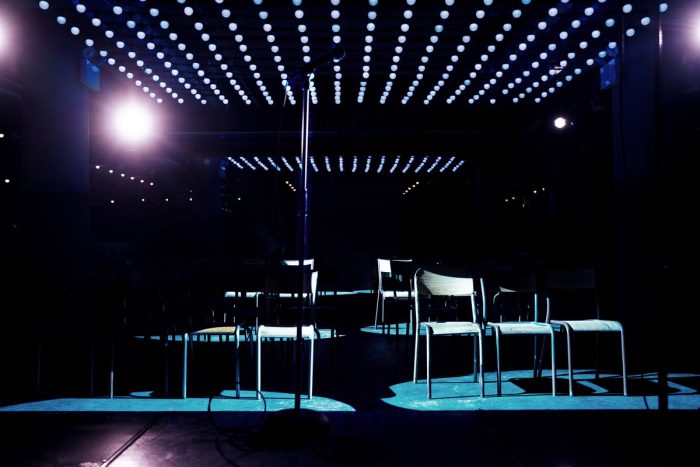COVID-19 Impact Assessment: Mixed-Use Environments
NELSON Worldwide conducted a comprehensive evaluation of COVID-19’s impact across industries to arm our clients and partners with short- and long-term solutions to best respond, adapt, and innovate.
This Impact Assessment identifies macro trends and implications that will drive shifts in business models, brand development, and the design of built environments—and ultimately, shape the human experience for retail centers and mixed-use environments.
COVID-19 Temporary Testing Facilities
The COVID-19 pandemic has ushered in a new urgency to quickly set up and adapt both public and private space for temporary testing facilities (TTFs). To help our clients, communities, and nation minimize ongoing pandemic impacts, we have developed a set of best practices and insights to safely and efficiently establish a TTF.
Building Design + Construction: Oracle Industry Lab enables development of solutions for multiple industries
The Oracle Industry Lab in Chicago, which provides customers in multiple industries the opportunity to test new technologies, recently opened. It is the first such facility for the IT giant that plans to add labs in England and Australia later this year. Read more with Building Design + Construction here.
Preparing Offices For The Safe Return Of Employees
Forbes discusses how offices can prepare for a safe return post-pandemic. With some employees hesitant, Forbes recommends NELSON Worldwide’s Scalable Workplace Solutions as a guide to help mitigate germs and ease workers’ concerns when going back to the workplace. Read more here.
Jeremy Hull
Part II: In The City with NELSON NYC
New York City is home to the largest population of designers in the country. Over 45,000 creatives work within the city limits each day making it a global hub for inspiration and creativity. NELSON New York is proud to be part of this community, designing some of the city’s most innovative environments, from corporate offices to retail flagships. To highlight all the exciting things going on “In The City” and at NELSON Worldwide, we’re unwrapping a three-part series that introduces some of our creative leaders and shares their thoughts on New York City’s design landscape.
Part I of our three-part In The City with NELSON NYC series introduces you to Joey Schirripa, Tenant Landlord Studio Director at NELSON NYC.
Q: Who are you as a designer? Tell us more.
As a designer, I am practical and balanced. I appreciate the visuals and aesthetics that can be accomplished by the use and manipulation of products and materials, but I am always conscious of cost, function, and longevity. This is not only important to me but the client which is why I always ask What is this going to look like day two? Is this easy to maintain? Is the design too specific to current trends that it will tire quickly?
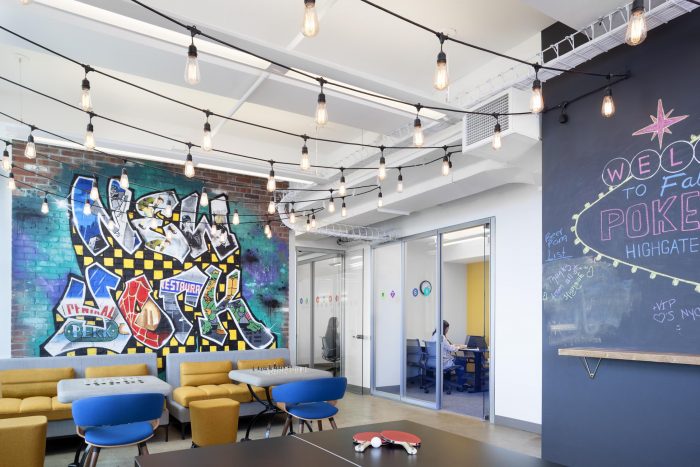
Q: 6 words that describe what it’s like to be a designer in NYC. Go!
Challenging
Interactive
Exciting
Forward-thinking
Engaging
Passionate
Q: What are some architecture and interior design trends in NYC you’re seeing at the moment?
At the moment, I am seeing the use of materials, lighting, and furniture that are multi-functional and allow plenty of flexibility within a space. We are designing interiors with the ability to be re-purposed so that users can easily adapt to changes with less movement and lower construction costs.
Q: How has the design landscape in NYC changed over time?
Over the years, design has become more open and accepting of the original structures and layouts of spaces. The brick and steel you find behind drywall is now the accent wall of a space. The rough beat up ceiling slab we use to conceal is now “perfect”. We are finding that the imperfect nature of these materials is now the finished look clients enjoy.
Q: What is the biggest challenge for design/designers in NYC?
A challenge for New York City designers and architects are is working with structural constraints within a project space. This City has a vast but unique range of architecture passed down from each era. Working around older methods and materials is always a challenge. For example, some buildings have wide column footprints used to fireproof them at the time. Our solution? We strip them down to the exposed steel and paint them. While finding these solutions may be challenging, they are also the things that make being a designer in NYC so special and exciting.
Q: What’s it like to work at NELSON NYC?
At NELSON every day is different! Being in the Tenant Landlord studio, the heart of our work is in NYC so we see it all and move very quickly. On an average day we could be in the office designing, working with brokers around the city, or standing on top of a 50-story building for review. All very exciting things that challenge my team and I to be creative and think on our feet.
Delaware Custom House
Design For Good: Modular Housing
California is experiencing an affordable-housing crisis in which 97% of cities are not keeping pace with its population growth in creating housing. Only about 10% of the number of units to support inbound workers has been produced each year for nearly a decade. Cities across the state are struggling to find solutions. The challenges range from aggressive NIMBYism, Planning Commissions paralyzed by political opposition by an array of constituents, and dramatically rising wages in places like San Francisco and New York, where affluent tech workers are gobbling up every variety of housing. The urgency of the challenges has prompted the formation of a “YIMBY Coalition”, lobbying for relaxed restrictions on new development.
One solution gaining significant traction is producing modular housing. “If we don’t build housing differently, then no one has any housing,” says Rick Holliday, a Bay Area developer who has built a modular housing fabrication factory near San Francisco.
The technologies vary but generally involve simplifying construction through prefabricated apartment units or freestanding “tiny homes”, deployed in different ways for different uses. The “Factory Built” modular methodology has a multitude of benefits. While modules are assembled at the factory, site work can begin concurrently, such as laying the foundation or prepping utility connections. This greatly decreases the time needed for total construction. Modular buildings are often completed 25-30% faster than conventional structures. Once the modules are ready, they are shipped to the site and fastened together. The final construction stage includes completing exterior systems such as cladding and roofing components and internal spaces like lobbies, stairwells, and elevator shafts. The finished building can take any form, from exposed industrial shipping containers to finished housing that’s indistinguishable from any site-built product. In general, this methodology has been shown to allow the completed product from a shovel in the ground to full completion in about 6 months. With actual all-in construction cost savings only in the +/- 10% range, time is the highest value to the developer or city.
The basic concept isn’t new. In 1624, Massachusetts settlers built homes out of prefabricated materials shipped from England. The pattern was repeated in Australia, Africa, and India as the British Empire shipped colonists and structures wide across the globe, according to “Prefab Architecture,” by Ryan E. Smith, a professor at the University of Utah.
The challenge is both political and functional. Housing across the entire spectrum of affordability must be produced through a variety of modes. Political will must shift to support streamlining approvals based on existing zoning and design guidelines, removing the option of neighborhood objection if the building is designed “as of right”. Additionally, cities must shift their focus toward housing, mostly at the lower end of the spectrum, where for-profit developers are few. The homelessness in most major cities is also a by-product of this dramatic housing shortage, as well as supportive services that are lacking. Many of these problems will take many years to overcome, but modular housing can offer more expedient ways to solve some of them.
1-San Jose Mercury News. “Housing shortage: New report shows how California cities and counties stack up”. February 1st , 2018
Leveraging Technology to Attract and Retain
Advancements in technology have been improving workplace productivity for years, allowing us to work virtually from anywhere. Now that a global pandemic is forcing us to work from home, the question being posed seems to be, why return to the office at all? According our “Evolving Workforce Expectations” study, only 7% of employees want to return to work a full five days a week. If employees are a company’s most valuable asset, employers must make the workplace a sought-after destination for everyone, one that people are excited to return to.
Brands will need to reevaluate their office portfolio and determine a plan to ensure their employees can take advantage of new technologies that make communicating, collaborating, and connecting, more seamless than ever before.
But while technology continues to rapidly evolve to better bridge the gap between physical and virtual workers, the most critical element for successful adoption and activation of these tools will be a robust change management strategy. Employers must provide holistic awareness, training, and buy-in to effectively activate these new, digitally focused offerings.
Here are the four ways technology can be used to make the workplace a sought-after destination:
Instant communication
Brands are having to communicate with their employees more than ever before, and because so many things are constantly evolving, the need for immediate communication is imperative.
Integrated workplace management systems like iOffice and their employee experience app Hummingbird, previously considered luxuries, will be necessities. With technology like this, employees can reserve workstations or conference rooms, submit service requests, be alerted to incoming mail, visitors, and more, all from their own mobile devices. Employers can also keep a close eye on who is in and out of their facility each day, constantly monitoring capacity to keep their employees safe.
As wearable technology gains more popularity, many employers are realizing these tools offer a unique opportunity to communicate with employees. With the traditional, in-office nine to five likely becoming extinct, a singular means of communication like email won’t be enough. And with employees working from a variety of environments including coffee shops, home offices, hotel lounges, and even their cars, wearable technology is something they’ll always have access to.
As the mobile workforce and risks of cyber security attacks continue to increase, innovative solutions like Samsung Knox are changing the way companies use wearables, embedding their software within workers’ mobile devices and smartwatches to secure company data, and help mitigate breaches of private company information.
Real-time collaboration
Collaboration tools will only gain more popularity during and after the pandemic. From video conferencing, to file sharing, there are numerous tools that will make the hybrid work day more seamless. It is no longer just about meeting virtually anymore, it is about going a step further to integrate with multiple platforms, support blended teams, provide robust collaboration opportunities, and the ability to accommodate smaller, breakout groups virtually.
Even before the pandemic tech giants like Microsoft were perfecting their cloud-based collaboration tools, but the social distancing, work-from-home mandates are accelerating this trend. These brands have taken a close look at how consumers have had to change their behaviors drastically in a short period of time and made improvements to their tools to make the digital experience as close as possible to the real-time experience.
Today, digital meeting facilitators can set up automated emails connected to their meetings, making it easier to manage attendance. They can also view a dashboard after to get a big picture report of attendee engagement. Video webinars can be recorded and later shared with the group along with a full transcript, file attachments, and any discussions from the chat window of a video or call. From custom backdrops, and screen sharing, to virtual chalkboards and collaborative documents, there isn’t much you can’t do remote anymore, making tools like these imperative when returning to the physical office.
Other tools such as Slack and Microsoft Teams reduce the amount of emails needed in a work day, by offering one, cohesive platform for teams to communicate. Mural is another online tool for ideation sessions, providing a more visual-based platform to facilitate blue-sky thinking.
Connection without distraction
Video conferencing technologies like Zoom are here to stay. Especially since many white-collar corporations are extending the work-from-home period until as late as next summer. This means many workers will need a hybrid environment to connect with clients, colleagues, and business partners. Many will still want their own desk space to retreat to for heads down work, but the popular open concept environments aren’t conducive for lengthy zoom meetings or other new-age virtual tasks.
Rethinking conference rooms of all sizes is one way to accommodate these new hybrid environments. Because guests, clients, and other visitors from outside of an organization are less likely to go into an office that isn’t theirs, large conference rooms, both within the tenant space, and the shared building, sit empty and unused.
These underutilized meeting rooms can be transformed to a few different types of meeting areas:
- Production Pod – For one-on-one video conferencing meetings, a place where employees can go to chat with their colleague who may be working from home, or their client who may not be comfortable coming into the office. Although there isn’t much square footage needed, the room must be sound proof, and equipped with all the AV technology needed to perform a seamless video call, including a large monitor with easy connection to a laptop, a power source, and good lighting for video visibility.
- Collaboration Suite – A little bigger and can accommodate a larger group. This room comes with everything the smaller production pod includes, but with an even bigger monitor with an auto-framing video camera to track and focus on who in the room is speaking and stacked theater seating for visibility. Creating a physical destination that puts blended teams on equal footing.
- Presentation Studio – A production room equipped with podcast equipment, a green screen, advanced sound and recording tools, will be beneficial for employees creating more elevated, digital content that will continue to remain the norm, years after the pandemic.
Essential safety
Revolutionary technologies are improving quality of life for millions of Americans living through this global pandemic. Telehealth services are increasing in popularity due to COVID-19, offering a safe way for patients to stay out of overwhelmed healthcare systems and prevent the risk of exposure. Smartphone and wearable technology tracking has even been used to trace contact of those infected with the virus.
When employees return to work, these types of technologies can make a huge difference. Employers and landlords can start small with zero-touch adjustments like automated doors and motion sensor lighting. Steelcase’s RoomWizard is a completely hands-free solution for meeting room reservations. Employees simply walk into an available room and begin working and the smart technology marks the room in-use.
Larger investments include innovative technologies such as body temperature walk-through kiosks, germicidal UV light, and more. Investing in technologies that make employees feel safe can go a long way and hold significant value.
In the end, the key to success when returning to work will be change management. Think about how quickly we’ve all adjusted to day-to-day routines like working from home, going to the grocery store, and dining out at restaurants. Wearing masks, temperature checks, and social distancing were once foreign behaviors none of us ever had to practice, a few short months later, it seems normal. Managing expectations and offering the tools and environment needed to communicate, connect, collaborate, and stay safe will set employees up for success and get them excited to return to the new workplace destination.
NYC Fluid Retail: Arts & Recreation Edition
New York Market Week is here and as retail continues to rapidly transform, we’re looking beyond the immediate industry, to environments and concepts inspiring the retail of tomorrow. Today’s consumers engage with brands in a fluid manner, the traditional sectors of the retail, restaurant, hospitality, and entertainment have blurred as the consumer-desired experience has become a mosaic of expectations, influenced heavily by engagement, access, and authenticity. Embracing these new expectations presents brands with a greater opportunity to differentiate, cross-sell and expand the breadth of their brand experience. So, this year while in the city we’ll be exploring some of the city’s most innovative new concepts across multiple industries, that we think could be a driving force in the retail experience of the future.
Our final Fluid Retail segment will focus on concepts revolving around Art + Recreation. Below you will find the best spots in and around NYC to immerse yourself in a creative experience whether it’s an art show, concert, or tour. (And if you missed our first two posts in the series make sure to check them out here: Food & Beverage and Hospitality + Wellness)
Snark Park | Sensory Park in Hudson Yards
Snark Park is a permanent “immersive installation” venue designed by New York City architecture firm Snarkitecture. Located at The Shops at Hudson Yards, the “park” is open to the public allowing visitors to interact with “aesthetically pleasing architectural experiences”. Inside, one can find plenty of photographable moments in the two-way mirrored room decorated with glowing tiles and an array of other materials that play to the senses.
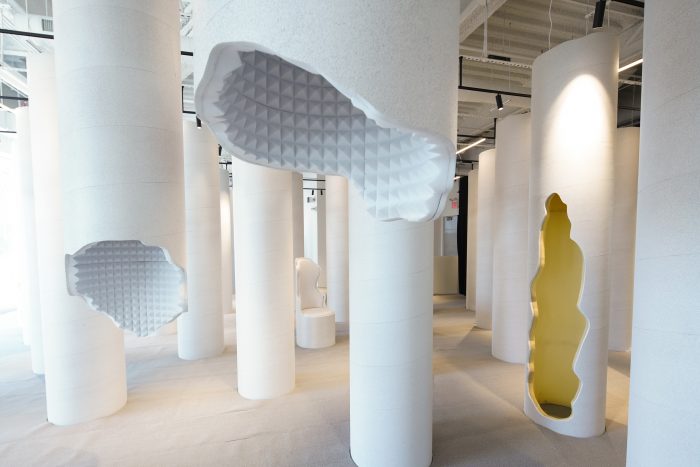
The New Pier 17 + South Seaport District | Lower Manhattan Developmen
The revitalization of Pier 17 and South Seaport District has been in the cue for years, and this year the restoration has begun to unfold. Spreading across 1.5 acres, the new Pier 17 Rooftop and mixed-use center is a concert venue, restaurant, park and more all in one. A variety of new shops have also opened near the Pier creating a new space for locals and tourist to enjoy the water.
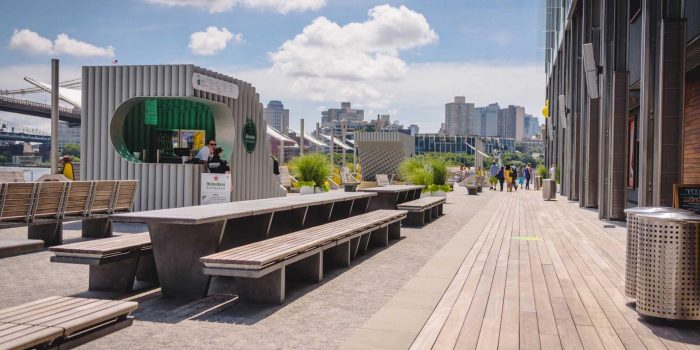
Brooklyn Grange | Rooftop Farm
Although Brooklyn Grange is not a new concept, it is growing. If you haven’t heard of it yet, the Grange is the world’s largest rooftop soil farm. Along with harvesting fresh produce, the farm offers tours, workshops, yoga, and educational programs. Private events and weddings are offered for reservation. Altogether, the Grange provides people with a fluid experience that inspires people to experience something they usually wouldn’t find in the city.

Showfeilds | SoHo Pop-up Home
Shopping can be art too, especially at Showfeilds where you get to explore a variety of brands through colorful, immersive pop-up experiences. From the bottom to the top of this four-floor studio, visitors can find a parade of rotating workshops, events, and retail concepts where you can play or observe a number of brand experiences.
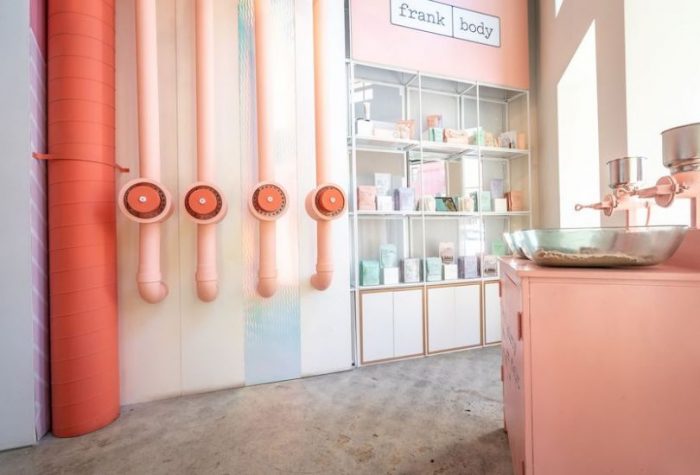
The Shed | Hudson Yards Venue
Called the “new center for the arts”, The Shed is an architectural wonder that plans to host established and emerging artists under one roof. The coolest thing about this venue is its adaptability. The venue can transition from indoor to outdoor with a sliding roof on wheels. Here you could see your favorite artist, watch a new film, or attended a speaking event.
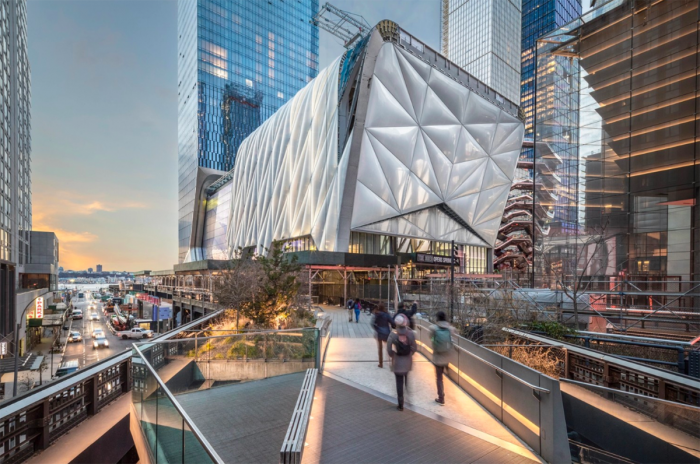
The Value Of Good Design | MoMA Exhibit
This Spring the MoMA is featuring an exhibit that highlights and explains the functional design elements that go into everyday items such as furniture, electronics, sporting goods, and more. The purpose of this exhibit is to explore the potential of design all the way from the 1930s to today. The exhibition also raises questions about what Good Design is and invites visitors to try out a few “good design” classics still in production.
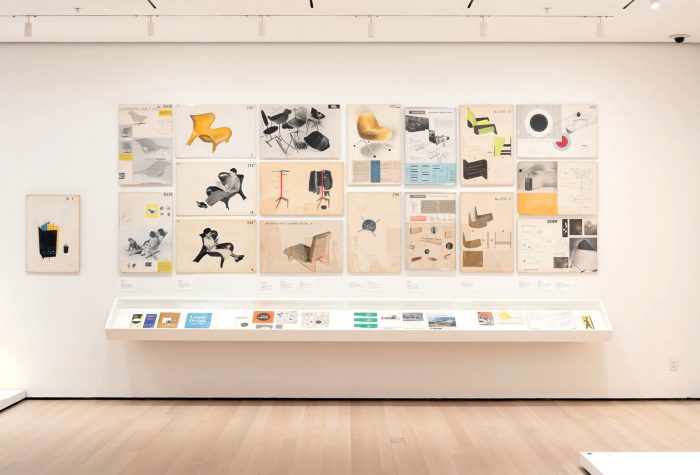
A/D/O | Brooklyn Creative Hub
This repurposed warehouse in Greenpoint, Brooklyn has been transformed into a creative workspace, restaurant, and design store all-in-one. A/D/O memberships allow individuals and businesses to access events, art installations/exhibits, launch parties, and a coffee/lunch bar. At the center of the 23,000 sf experience the “Periscope“, a prism-shaped mirrored skylight window, becomes the focal point, allowing light flow throughout the space.
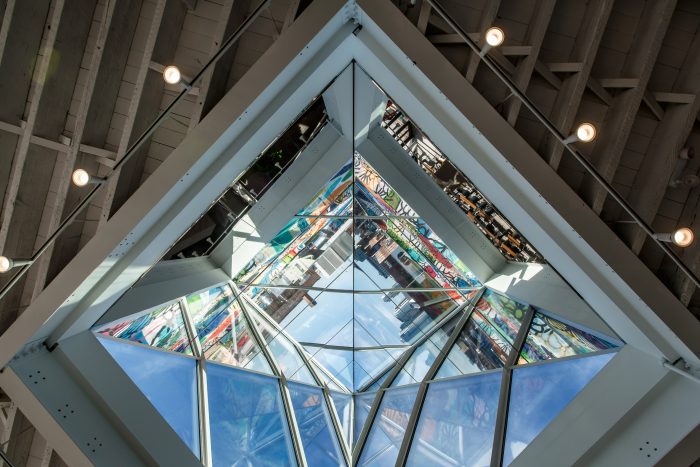
Chelsea Music Hall | Underground Concert Venue
In fall of 2018, Chelsea Market opened an underground music hall offering dinner theater, concerts, comedy and food. Unlike most music venues, Chelsea Music Hall does focus on one specific genre of entertainment. The 250-occupant space will give performers and entertainment seekers of all kinds a unique venue to try new things. The music hall is also home to a highly anticipated menu brought to you by one of the Market’s upstairs vendors.
